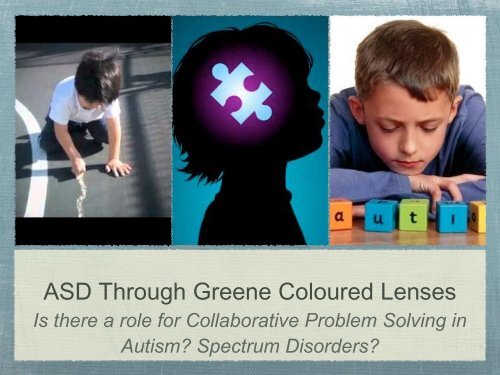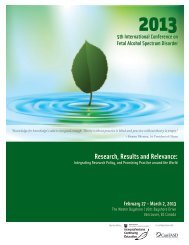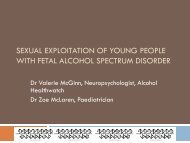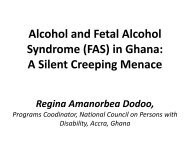Is there a role for Collaborative Problem Solving in Autism?
Is there a role for Collaborative Problem Solving in Autism?
Is there a role for Collaborative Problem Solving in Autism?
Create successful ePaper yourself
Turn your PDF publications into a flip-book with our unique Google optimized e-Paper software.
BC Interior ADHD Cl<strong>in</strong>ic - whatwe seeChildren/ Youth with an ASD diagnosis (struggl<strong>in</strong>g withresources, treatment, school, home and relationshipfunction/ attentional difficulties part of overall picture)Children Youth referred <strong>for</strong> an ADHD assessmentwhere ASD has not yet been identified as a potentialdiagnosis
BC Interior ADHD Cl<strong>in</strong>ic - whatwe seeFamilies: struggl<strong>in</strong>g to secure resources, implementassessment recommendations and navigate acomplex system.Children/ Youth that are struggl<strong>in</strong>g with academicsand behaviour at school, conflict and “explosiveness”at home.
Any “behaviourists”<strong>in</strong> the room?disclaimer!!
ObjectivesReview the <strong>Collaborative</strong> <strong>Problem</strong> <strong>Solv<strong>in</strong>g</strong> model with a focus on the“lens,” through which challeng<strong>in</strong>g behaviour is viewed.Review the key similarities and differences between the plann<strong>in</strong>gprocess <strong>for</strong> CPS and a traditional behaviour approach/ functionalanalysis.Discuss case examples from community sett<strong>in</strong>gs where CPS hasbeen implemented with <strong>in</strong>dividuals with ASD, their families andcaregivers.
what are your explanations?What the possibleexplanations <strong>for</strong> theproblem?“He’s just look<strong>in</strong>g <strong>for</strong> attention”
Deal<strong>in</strong>g with <strong>Problem</strong>behaviourPhilosophy - Children do well if they want toAssumption - They don’t want toGoal - Make them want toMethod - Reward/ PunishmentCause - Learned behaviour? Poor parent<strong>in</strong>g? Inconsistency?Labels - Unmotivated, attention-seek<strong>in</strong>g, manipulative, avoid<strong>in</strong>g etc.Intervention - Help Parents be more consistent, cont<strong>in</strong>gent
Deal<strong>in</strong>g with <strong>Problem</strong>behaviourPhilosophy - Children do well if they canAssumption - Someth<strong>in</strong>g is <strong>in</strong> their wayGoal - F<strong>in</strong>d out what is <strong>in</strong> their wayMethod - <strong>Collaborative</strong> <strong>Problem</strong> <strong>Solv<strong>in</strong>g</strong>Cause - Skill deficits <strong>in</strong> flexibility/ adaptability, frustration tolerance,problem solv<strong>in</strong>gLabels - Skill deficit, learn<strong>in</strong>g difficulties, developmental delayIntervention - Assess skill deficits, teach skills
CPS and autism spectrumdisorders?'It’s often assumed that the CPS modelhas no application to autistic kids, andthat well-known applied behaviouranalysis methodology is really the onlyoption. I beg to differ. “<strong>Autism</strong>spectrum” doesn’t say anyth<strong>in</strong>g aboutthe kid’s general cognitive function<strong>in</strong>g,and unless you’re ready to throw <strong>in</strong> thetowel on teach<strong>in</strong>g the kid lagg<strong>in</strong>g skillsor help<strong>in</strong>g him learn to solve problems– and hopefully, you’re not – then CPSmay well have a <strong>role</strong> to play.Ross Greene
FBA1Describe/ VerifySeriousness of problem3Analyze In<strong>for</strong>mation24Ref<strong>in</strong>e the def<strong>in</strong>itionCollect <strong>in</strong><strong>for</strong>mation onpossible function5Generate hypothesisregard<strong>in</strong>g probablefunction6Test hypothesisregard<strong>in</strong>g probablefunction7Develop and implementbehaviour plan
FBASome mechanism <strong>for</strong> per<strong>for</strong>mance/ skill deficitconsideration when categoriz<strong>in</strong>g behaviourHelps identify situations and triggers <strong>for</strong> behaviourFocus on purpose or function of behaviourBehaviour serves to “get someth<strong>in</strong>g” or “avoidsometh<strong>in</strong>g”Then teach/ re<strong>in</strong><strong>for</strong>ce replacement behaviours thatserve the same function. (ie “Get attention, avoidwork.”
CPS Key differencesSkill deficit + trigger/ situation = maladaptivebehaviour/unsolved problemAssess skill deficit, understand child’s perception/concern, solve problem collaborativelyThe “function” of the maladaptive behaviour is to let usknow: someth<strong>in</strong>g is <strong>in</strong> the way of the child do<strong>in</strong>g wellFocus is on skill development/ collaboration
ASD - is cps a fit?(Discussion)CPS requires some degree of communicationWhat if the lagg<strong>in</strong>g skills are <strong>in</strong> the areas ofcommunication/ language?“Back up the bus,” work on acquir<strong>in</strong>g language/communication around the unsolved problemThen . . .Plan B discussionsThe “CPS Lens”
a few words on processWhile solv<strong>in</strong>g aproblem us<strong>in</strong>g PlanB is an importantgoal, it isn’t the onlygoalIt’s the Plan Bprocess that helpswith understand<strong>in</strong>g,relationship andskill-build<strong>in</strong>g
The Process - tra<strong>in</strong>sreflection, flexible th<strong>in</strong>k<strong>in</strong>gand problem solv<strong>in</strong>gAre Skills Taught with Plan B?Indirect versus Directteach<strong>in</strong>gIdentify<strong>in</strong>g and express<strong>in</strong>gconcerns / separat<strong>in</strong>g affect(Step One)Tak<strong>in</strong>g other’s perspective,impact on others, empathy(Step Two)Generation of solutions,problem solv<strong>in</strong>g, anticipat<strong>in</strong>goutcomes, mov<strong>in</strong>g off o<strong>for</strong>ig<strong>in</strong>al ideas (Step Three)
The CPS Lens - Keep<strong>in</strong>g ourTriggers <strong>in</strong> CheckRelated to ourbeliefs and valuesRelated to ourexplanationsL<strong>in</strong>ked to our ownself awarenessBiological l<strong>in</strong>k
amygdala hi-jack!beware . . .
Can we have “Dead End Explanations?”“He has bipolar disorder“He has FASD”“She’s adopted”“She just wantsattention”“He wants his own way”“He’s manipulat<strong>in</strong>g us”“He has an attitudeproblem”“She is mak<strong>in</strong>g badchoices”“She won’t cooperate”“He wants control”
How do we know if our explanation is aDead End?Explanation Litmus Test: “If my explanationguides my <strong>in</strong>tervention, what would I do next?Have I been left at the “doorstep” of<strong>in</strong>tervention?”
CPS can be messy
Videos and Case StudyDiscussion
Summary - CPS and ASDMore research needed with ASDConsideration of severity (language/communication)Direct versus Indirect teach<strong>in</strong>g (social skills/language/ communication and cognitive skills)Process component - <strong>in</strong>volv<strong>in</strong>g the child
Summary - CPS and ASDThe “Lens” is a key piece with parents andcaregiversChildren do well if they canExplanation guides our <strong>in</strong>terventionCan help with “Amygdala Hijack”
Remember your lens . . . .thank you!Kids Will Do WellIf They Can
References• Greene, R (2009) www.lives<strong>in</strong>thebalance.orgInternet site and contact <strong>in</strong><strong>for</strong>mation regard<strong>in</strong>g<strong>Collaborative</strong> <strong>Problem</strong> <strong>Solv<strong>in</strong>g</strong> Model and Dr. RossGreene.•• Ablon, S (2009) www.th<strong>in</strong>kkids.org Internet site andcontact <strong>in</strong><strong>for</strong>mation regard<strong>in</strong>g the <strong>Collaborative</strong><strong>Problem</strong> <strong>Solv<strong>in</strong>g</strong> Model, Massachusetts HospitalTh<strong>in</strong>k Kids organization and Dr. Stuart Ablon.
References• Parent<strong>in</strong>g Children with Disruptive Behaviours: Evaluation of a <strong>Collaborative</strong> <strong>Problem</strong><strong>Solv<strong>in</strong>g</strong> Pilot Program Journal of Cl<strong>in</strong>ical Psychology Practice 2010 (1) 27-40• Reduction of Restra<strong>in</strong>t and Seclusion Through <strong>Collaborative</strong> <strong>Problem</strong> <strong>Solv<strong>in</strong>g</strong>: A Five-Year Prospective Inpatient Study Psychiatryonl<strong>in</strong>e.org, Dec 2008 Vol 59 No. 12• Greene R, Ablon J, Hassuk B, et al: Use of collaborative problem solv<strong>in</strong>g to reduceseclusion and restra<strong>in</strong>t <strong>in</strong> child and adoles- cent <strong>in</strong>patient units. Psychiatric Services57:610–612, 2006• Greene RW: The Explosive Child: A New Approach <strong>for</strong> Understand<strong>in</strong>g and Parent<strong>in</strong>gEasily Frustrated, Chronically Inflexible Children, 2nd ed. New York, Harper Col- l<strong>in</strong>s,2001• Schaubman, Averi et al: Reduc<strong>in</strong>g Teacher Stress by Implement<strong>in</strong>g <strong>Collaborative</strong><strong>Problem</strong> <strong>Solv<strong>in</strong>g</strong> <strong>in</strong> a School Sett<strong>in</strong>g. School Social Work Journal. Vol. 5. No. 2. March2011
References• Kimberly D. Becker • Bruce F. Chorpita • Eric L. Daleiden: Improvement <strong>in</strong> SymptomsVersus Function<strong>in</strong>g: How Do Our Best Treatments Measure Up? Adm Policy MentHealth. Published Onl<strong>in</strong>e 05 Jan 2011• Greene, R., Ablon, J., Monuteaux, M., Gor<strong>in</strong>g, J., Hen<strong>in</strong>, A., Raezer, L., et al. (2004).Effectiveness of collaborative problem solv<strong>in</strong>g <strong>in</strong> affectively dysregulated youth withoppositional defiant disorder: Initial f<strong>in</strong>d<strong>in</strong>gs. Journal of Consult<strong>in</strong>g and Cl<strong>in</strong>icalPsychology, 72, 1157–1164.











